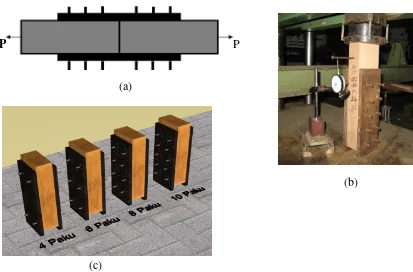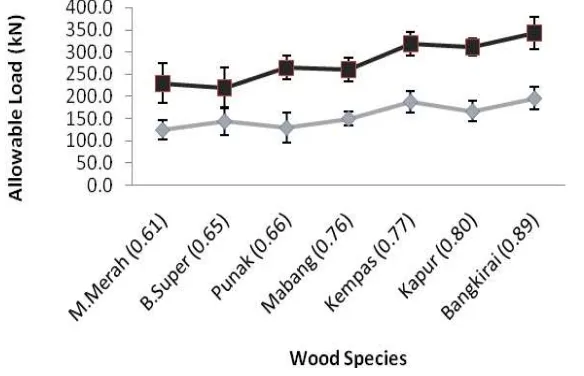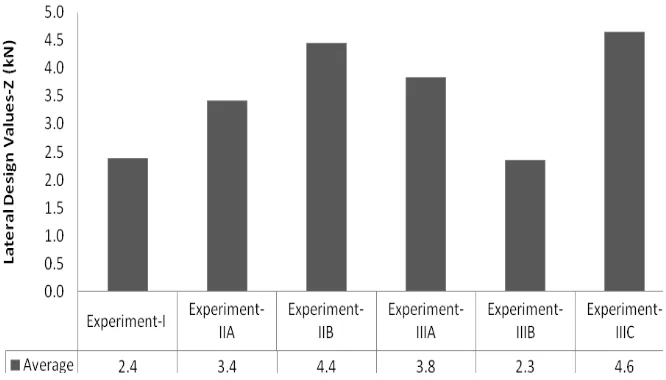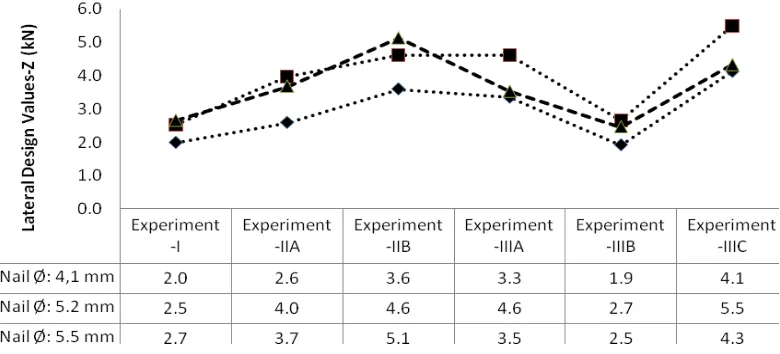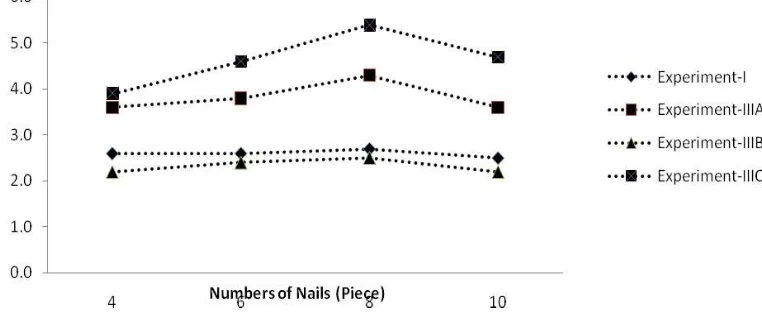Lateral Design Value (Z) for Various Double Shear Multi-Nailed Wood
Connections with Steel Side Plates
Sucahyo Sadiyo
Department of Forest Products, Faculty of Forestry, Bogor Agricultural University Kampus IPB Darmaga Bogor 16680 Indonesia
Corresponding author: [email protected] (Sucahyo Sadiyo)
Abstract
Experiments were conducted to analyze the lateral design value (Z) for double shear wood connections using multiple nails with steel side plates of seven different Indonesian tropical wood species under uniaxial compression loading. Results showed variations in average wood moisture content (MC) for nail connections, the lowest in Kempas to the highest in
Bornean Super wood. Whereas for average specific gravity (SG), density (ρ), allowable load compressive stress parallel to grain (Ftk//) and tensile stress parallel to grain (Ftr//), the
lowest was in Meranti merah and highest in Bangkirai wood. Values for Ftk//, Ftr// and Z tent
to be proportional to the wood’s SG or ρ. Ftr// values were 1.5 to 2 times higher than Ftk//.
Pattern or parallel line distribution of average Z values among the experiments was relatively similar. The highest Z value was obtained by 5.2 mm nail followed by 5.5 mm nail for all experiments, except experiment-I (theoretical) and experiment II-B (EC5 2007). Generally, the number of nails did not provide significant effect (relatively uniform) on the average Z value double shear connections.
Key words : double-shear connections, lateral design value, uniaxial compression loading, tropical woods
Introduction
Predominantly, a structural building must meet three important requirements, i.e. stiffness, strength and structural stability, where one of the influential factors is type of connection. Wood connection is the most critical or the weakest point of structural building elements. On structural building framing system, all framing components (including the connections used) should be subjected to uniaxial tensile and forces only.
Types of wood connections that are critical and need to be considered based on scientific principles are tensile connection, shear and moment, because the strength of wood connections especially in bearing
the tension force of the contact area from its main stem, was replaced by tensile or shear area from its connection tools so that the connection tensile strength were generally lower and difficult to match the strength of the main stem. Wood tensile connections are also susceptible to
displacements and this is another
weakness.
Dowel type fasteners such as nails are relatively cheap, easy to obtain in the market and easy to work with. It is customary for practitioners in the United States to use nails for connection design considering the relatively small acting forces. Although nails are generally used for light constructions, they can also be used for heavy timber construction, such
as those carried out by several
construction designers in Europe and New Zealand (Breyer et al. 2007). This, however, contrasts with Indonesian case where research on full scale wood connection using multiple nails for wood species having medium to high specific gravity or density were rarely been
conducted, not to mention their
applications on heavy timber
constructions.
This research has the objective to analyze the lateral design values (Z) of double-shear wood connections using multiple nails with steel sided plates of seven kinds of Indonesian tropical wood species under uniaxial compression loading based on various experiments.
(Tetramerista glabra), Kapur
(Dryobalanops spp), Mabang (Swintonia
sp), Kempas (Koompassia malaccensis) and Bangkirai (Shorea laevis). The timbers were collected from building material shop in Bogor in the form of wood beams with dimensions of (60 x 120 x 4000) mm3. The woods were naturally were drilled on each steel plate where the size was adjusted to the diameter of the nail while nail spacing were adjusted to the size of woods and connection plate
(AWC 2005). Physical properties
measurements consisted of density (ρ),
specific gravity (SG) and moisture content (MC), were calculated in accordance with American Standards, as given in American Society for Testing and Materials (ASTM) D 143-94. The mechanical properties testing of ultimate compression strength were calculated as specified in British Standard BS-373:1957 and strength of
double shear multi-nailed wood
connections with steel side plates was calculated based on ASTM D5652-95
(Reapproved 2000). Tensile strength parallel to grain was inferred from models or empirical equations developed by Tjondro (2007). The average size of the specimen MCS during the testing was (20 x 20 x 60) mm3 and the specimens for
MC, ρ and SG were obtained from the
same sample measuring (50 x 50 x 50) mm3. The test specimen for double shear connections was originally obtained from 2 pieces of wood beams of the same species and sizes, with each beam measuring to (60 x 120 x 400) mm3 (Figure 1a). However, during the testing, only one beam was used since the testing was conducted using uniaxial compression
load (Figure 1b). The mechanical
Baldwin universal testing machine with capacity of 30 tons and Instron UTM with
capacity of 5 tons respectively.
P P
(a)
(b)
(c)
Figure 1 Sketch of double shear connections test specimen with six nails (a), uniaxial compressive testing with ten nails (b) and sketch for test specimen according to number of nails (c) for double shear multi-nailed wood connections with steel side plates.
Determination of tensile strength parallel to grain followed the empirical equations Ft// = 172.5 SG1.05, where SG is wood
density measured at 12-15% moisture content (Tjondro 2007). The lateral design value (Z) for double shear connections was analyzed under various experiments. Experiment-I was based on a theoretical approach in determining the strength or lateral design value (Z) for double shear connection. The lateral design values (Z) referred to the notation that describes the Allowable Stress Design (ASD) value per nail of double shear connections obtained from yield limit
equations (AWC 2005). Experiment-II
was a hybrid between theoretical approach and empirical tests. Determination of lateral design value (Z) was divided into two standard approaches, namely the United States (AWC 2005), here in after referred to experiment-IIA trial and the
European Union, Eurocode 5(EC5)
(Porteous & Kermani, 2007), here in after referred to experiment-IIB. Experiment-III was an empirical test to determine the lateral design value (Z) of double shear connections of seven Indonesian tropical wood species at various diameters and number of nails. Experiment-III was divided into three classifications that is experiment-IIIA, IIIB and IIIC where each of the Z value was determined at proportional limit, maximum limit and displacement limit at 1.50 mm.
In this study, Z was determined at several displacements, i.e. at 0.38 mm (FPL
the elastic-linear region of
load-displacement curve. Whereas for the latter mentioned displacement, the standard testing for double shear connections
indicated that at 5.00 mm displacement, both the single and double shear connections were assumed to have suffered destruction (plastic-in linear region).
To study the behaviour and determine the influence of diameter and amount of nails on the Z value of double shear wood
Specific gravity, density and moisture content
classified as having high ρ. Classifications
were made considering the wood specific gravity, which was an indication of wood density.
Differences in specific gravity were caused by different wood anatomical structures which comprised of types, amount and distribution of vessels, parenchyma, ray and intercellular canal. The value of SG was mostly determined by the thickness of cell wall. The thicker the cell wall or the smaller the proportions of void structure contained in the wood at specific volume, the higher was the
was primarily determined by the diameter and frequency of vessels, voids and the presence of intercellular canal (Sadiyo 1989).
The average ρ value of the woods was
higher than the average SG. The
difference was mainly due to the effect of MC during measurement. Distribution of MC of nailed connection beams varied research were less than the fibre saturation point (30%) although there were three wood species that had not reached the expected equilibrium moisture content
(EMC), namely Mabang, Borneo super contents were influenced by various factors, such as wood species, growth site and age of trees (Haygreen & Bowyer 1993). The high moisture contents of three wood species (> 18%) indicated that the natural drying time of 75 days was not able to reduce the moisture content to reach EMC relative to the surrounding RH and temperature.
Allowable load compressive and tensile parallel to grain
Distribution of allowable load
compressive stress parallel to grain (Fc//)
for wood beam with nail connections varied from the lowest in Meranti merah
with a load cell of 124.5 kN and the
highest is Bangkirai with 195.8 kN
(Figure 3). Punak wood with high density
(0.66) yielded lower average Fc// (129.7 characteristics. Difference in compressive strength in this research was contradictive
because the average MC and ρ of Borneo super was higher than Punak wood whereas it should be linear with its compressive strength. The distribution pattern of this phenomenon was the same
as the wood’s SG. This anomaly was
predicted due to the interlock grain in
Borneo super that could increase the compressive strength. This symptom was also seen in Kapur wood despite its higher
ρ (0.80 g.cm-3
) compared to Kempas (0.76 g.cm-3) but its average Fc// (166.5 kN) was
lower than Kempas (188.4 kN). This
property indicated that other than
orientation of the interlock grain, the
bonds between the wood’s cell rays and
between the cell rays with nearby cells were quiet strong hence the resistance to compressive load was high. Therefore,
neither ρ nor SG was the main variable in
determining the strength of a particular wood species. Although in general there
was a tendency that ρ or SG was
proportional to the wood strength. Figure 4 showed the tendency that distribution pattern of the average Fc// was proportional
to the allowable load of tensile parallel to
grain (Ft//), although significant
contradiction was shown on other kinds of
wood. Meranti merah and Punak had
lower average Ft// values than the Borneo super wood, despite their higher Ft//
Figure 3 Specific gravity of seven tropical wood species.
Borneo superwood seemed to have high ρ
and Ft// but not comparable with its Ft//.
Actually the average Ft// value is linear
because it is derived and obtained from a tensile strength parallel to grain empirical
equation (Tjondro 2007). However,
considering the adjustment factor on the strength and stiffness of maximum wood moisture content of 19% and 15% (ASTM D 143-94), the distribution of average allowable tensile load parallel to grain for the 7 species of wood showed a pattern which was closer to the average allowable compressive load parallel to grain as compared to the distribution pattern of SG
or ρ. The average Ft// was obtained from
an empirical test of undefected small specimen.
Lateral design value (Z) based on various experiments
Regardless of the effects of various studied variables, in general the resulted average Z for double shear connections from experiment-I (U.S. standard) was relatively similar to experiment-IIIB (Figure 4). The latter experiment was an empirical test of double shear connections with multiple nails and considering the
safety factor of 2.75 (BPID 1979). Hence, designers in construction applications could use the structural design values of double shear connections using nails based
on experiment-III because it was
considered relatively safe. The value of the two experimental designs mentioned above were much lower and significantly different compared to results obtained from experiments-IIA, -IIB and especially with -IIIC. If construction practices were based on BPID (1979) which limit the connection displacement at 1.50 mm, then the Z value used would be overestimated since the actual connection had passed the proportional limit (about 1.24 to 0.14 mm) (Sadiyo 2010). The Z value by BPID (1979) was slightly higher than those obtained from experiment-IIB.
Results from experiment-II, which
combined theoretical approach with
determination of Z which was based on
maximum load (BPID 1979).
Nevertheless, design values resulted from experiment-IIB that was based on EC5 (Porteous & Kermani, 2007) showed that the values were above the proportional limit even close to BPID (1979) values or had entered the plastic region. Taking into account various factors, including the determination of shear connection in accordance to Australian Standard (0.80 mm), the value of proportional limit displacement resulted from this study and the magnitude of its SD, yielded that 1.00 mm displacement could be set as a safe limit for double shear connection strength using nails with steel side plate.
Determination of lateral design value (Z) based on maximum load (destroyed) was calculated by dividing the maximum load per nail with a safety factor of 2.75
(BPID 1979). If the lateral design value Z at the limit of 1.00 mm displacement could be use as the basis for double shear connection design practices, then the specified safety factor (BPID 1979) was still considered too high. Results of this study showed that the safety factors based on the 1.00 mm displacement limit, ranged from the lowest at 1.54 (Kapur), followed by 1.74 (Meranti merah), 1.78 (Mabang), 1.89 (Bangkirai), 1.94 (Kempas), 1.97 (Punak), and 2.10 (Borneo super). Results of the study also showed that there were variations in the distributions of the safety factors of the seven types of wood. or significantly different, thus for the security interests of the connections in a building structure, the highest safety factor of 2.10 should be assigned.
Figure 4 Distribution pattern of lateral design value (Z) for various double shear wood connections using nails with steel side plates.
There was a general tendency that the average Z would increase significantly with increasing wood density. Similarly, the pattern or parallel line distribution of the average Z was relatively similar
was not the anomaly but Kempas wood with its interlock grain which despite having lower SG than Kapur, it has higher average Z value.
Based on the size of the diameter of the nail, the pattern of distribution or the average Z-line alignment is relatively
equal among the three diameters of nails especially between 4.1 to 5.2 mm nails according to various approaches. From the point of the study according to various phenomena the distribution approaches the average Z is equal to the average distribution of the general Z (Figure 6).
Figure 5 Distribution pattern of lateral design value (Z) for double shear nailed wood connections with steel side plates for seven wood species at various experiments.
(a). Kempas (b). Kapur
Figure 7 Distribution pattern of lateral design value (Z) for double shear nailed-wood connections with steel side plates according to nails’ diameters at experiment various.
At 5.2 mm diameter, nail gave the highest value of average Z followed by a 5.5 mm nail for almost all approaches, except for experiment-I and IIB (EC5 2007) where the Z value of 5.5 mm nail was higher than the 5.2 mm nail. The lowest average of Z resulted from 4.1 mm nail for all experiments. Besides the allegedly low quality of the nail, such difference was also caused by the greater nail surface area (5.5 mm as compared to 5.2 mm), making it easier to shift or split fibres parallel to the direction of trunk axis and forced into perpendicular to the wood fibres as the initial cracks or rip wood. The high SG factor in a 5.2 mm nail indicated that it contained high element of steel which could also improved the flexural strength of the nail.
Diversity analysis showed that the total number of nails namely 4, 6, 8 and 10
pieces did not provide significant
influences on the average Z value for double shear connections or in other words
relatively uniform, i.e. 2.3 kN
(experiment-IIIB) and 2.6 kN
(experiment-I), although it was not shown
by experiment-IIIA and IIIC (Figure 8). In experiment-IIIA, the average value of Z for 8 nails (4.3 kN) was significantly different and higher than the other three number of nails which gave a relatively uniform Z values (3.7 kN). Figure 8 also showed that average value of the averageline phenomenon for average Z values for double shear connection in experiment-IIIC was relatively parallel
although slightly above that of
Figure 8 Distribution pattern of lateral design values (Z) of double shear connections based on the number of nails at various experiments.
BPID (1979) also mentions that if within one line there is less than 10 nails, then the strength of the nail, regardless on the one connection (single shear) as well as two connection (double shear) does not need to be reduced. This statement implied that the use of up to 10 nails would not provide significant differences on the average strength per nail (lateral design value, Z).
Such different phenomenon was caused by the geometric or more even and stable distances between nails on 8 nails arrangement than the other three number of nails. Although there were differences in the lateral design value (Z) with 8 nails (experiment-IIIA and IIIC), however, for practical purposes of field connection design planning, these differences could be ignored due to meaningless information or the design value can be replaced by the lowest Z value.
Conclusion
There is a general tendency that the lateral design value (Z) for double-shear wood connection using nails with steel side plate increases with increasing specific gravity or wood density for all shears (0.38, 0.80, 1.50 and 5.00 mm). Thus Bangkirai,
Kempas and Kapur woods have average higher and significantly different Z lateral design values than the Borneo super,
Meranti merah, Punak and Mabang. However, despite having higher SG,
Kapur wood showed lower Z value than
Kempas wood.
The average value of Z for double shear connection based on experiment-I was relatively similar and insignificantly
different from experiment-IIIB
(maximum). Nevertheless, the Z values from both experiments were much lower than the average Z values obtained from
experiment-IIB and experiment-IIIC
(displacement limit of 1.5 mm). Thus the most realistic lateral design value (Z) for
Indonesian tropical wood was the
the average lateral design value (Z) for double-shear connections.
Acknowledgement
The authors are gratefully acknowledge the financial support by the General Directorate for Higher Education, the
Ministry of National Education.
Mrs.Yeyet, Mr. Sriyanto, Mr. Ace
Amirudin Mansur dan Mr. Riva
Fachrurrazi of under graduate alumni from Forest Product Department, Faculty of Forestry, Bogor Agricultural University, Indonesia are thanked for their assistances concerning specimen preparations and measurement set up carried out within his work.
ASTM D5652-95 (Reapproved 2000). West Conshohocken: ASTM.
[ASTM]. American Society for Testing and Materials. 1994. Standard Practice for Evaluating Allowable Properties for Grade of Structural Lumber. Methods for Mechanical Fastener in Wood. ASTM Standard D5652-95. Annual Book of ASTM Standard v4.10. Philadelphia: ASTM.
[AWC]. American Wood Council. 2005. National Design Specification: For
Wood Construction, ASD/LRFD.
Washington: American Forest & Paper Association.
Beery WH, Ifju G, McLain TE. 1983. Qualitative Wood Anatomy-Relating
Anatomy to Transverse Tensile
Strength. Wood Fiber Sci. 15:395-407.
Bleron L, Duchanois G. 2006. Anggle to
the Grain Embedding Strength
Concerning Dowel Type Fasteners.
Forest Prod. J 56 (3): 44.
[BPID]. Building Problem Investigation Directorate. 1979. Indonesian Wood Construction Rule, NI-5. Bandung:
Building Problem Investigation
Normallyzation Foundation.
Courtney TH. 2000. Mechanical
Behaviour of Materials. New York: McGraw-Hill-Publishing Company.
Faherty KF, Williamson TG. 1989. Wood Engineering and Construction Handbook. New York: McGraw-Hill Publishing Company.
[FPL]. Forest Products Laboratory. 1999.
Wood Handbook: Wood as an Engineering Material. Wisconsin: USDA Forest Service.
Hoyle RJJ. 1973. Wood Technology in The
Design of Structure. Montana: Mountain Press Publishing Company.
Pun CY. 1987. Structural Timber Joints. Malayan Forest Record No. 32. Kuala Lumpur: Forest Research Institut Malaysia.
Sadiyo S. 1989. Effect on Wood Species and Adhesive Type Combination To Physical and Mechanical Properties of Hull Diagonal Composite [Thesis]. Bogor: Faculty of Forestry. Bogor Agricultural University.
Suryokusumo S, Sadiyo S, Marzufli,
Bismo AA, Setyo AC. 1980. Wood
Engineering System. Study of Nail and Nail Plate Connections. Bogor: Forestry Faculty, Bogor Agricultural University.
Tjondro JA. 2007. Behaviour of Single-Bolted timber Connections with Steel Side Plates Under Uni-Axial Tension
Loading. [Dissertation]. Bandung:
Parahyangan Katholic University.
Wirjomartono S. 1977. Wood
Constructions. Jogjakarta:Engineering Faculty Press.
Riwayat naskah (article history)
